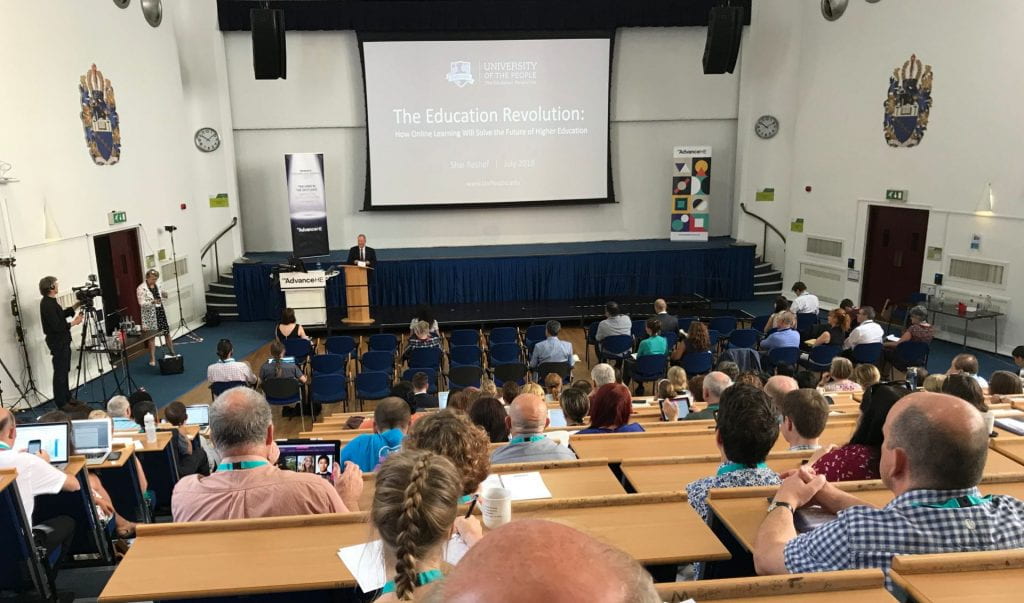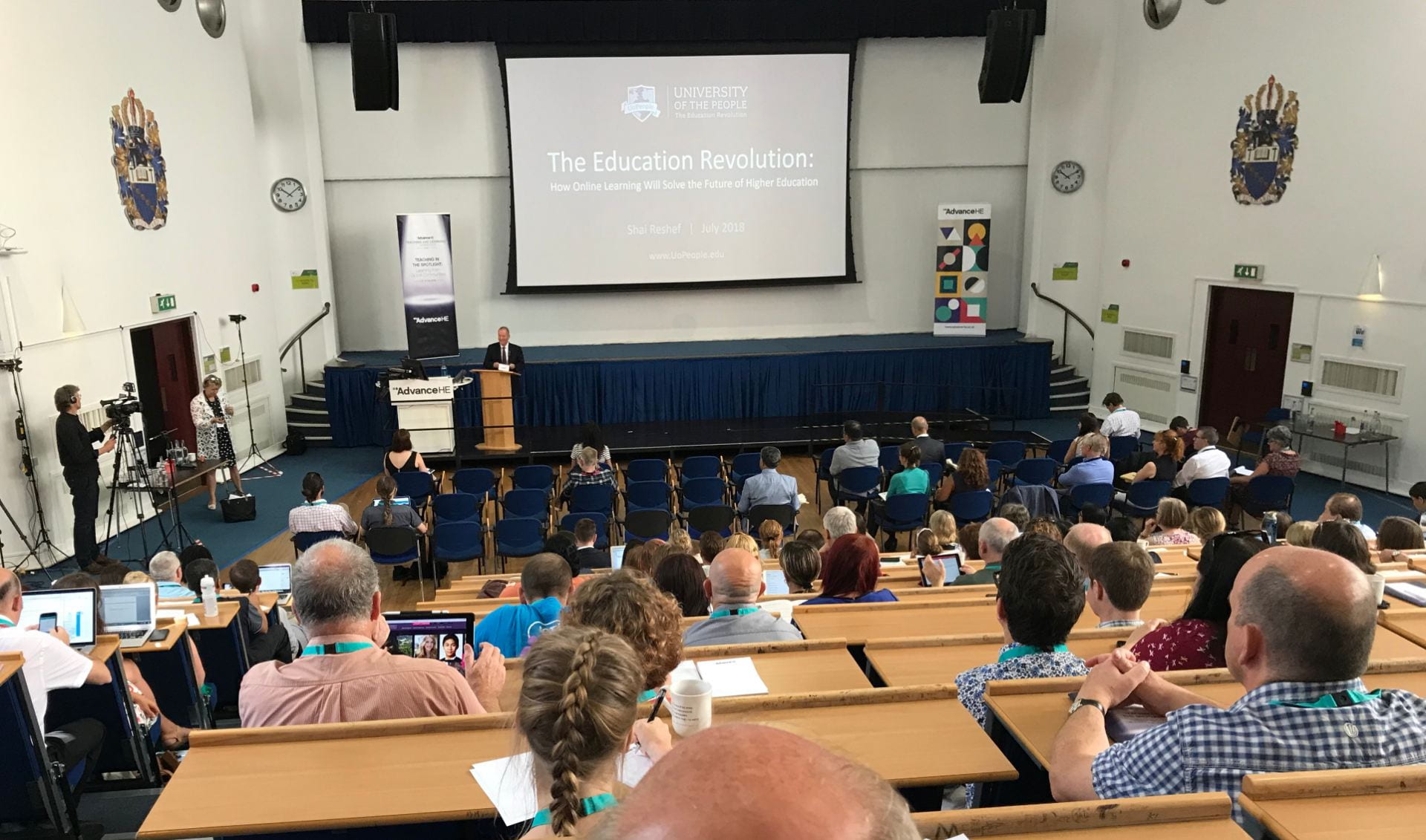
This is the second post in my #ArchiveReflections series – a collection of blog posts that look back on events that I’ve participated in in some way but not yet managed to write about.
In the summer of 2018, I presented a workshop at the Advance HE Teaching and Learning conference, titled ‘Learning to fly: Tips and tricks from classroom experiments in live international collaboration‘. This session recounted a series of undergraduate Aviation-focused seminars that I’d worked on with Dr Ivan Sikora (then SMCSE), which brought a friend and colleague of Ivan’s from the sector into the London classroom while he was sat at home in Auckland, New Zealand. ‘Learning to fly’ was also a chance to showcase the approach that we’d taken, via the same tools that we’d used in Ivan’s class.
I joined Day Three of the conference. It was great to have an opportunity to contribute to the programme of this conference, given that it is a key teaching and learning event in the UK Higher Education calendar and gave me an opportunity to share some of the work that we’ve been doing at City with an audience wider than just those within the educational technology field. It was also a highly internationally-focused event, and gave me exposure to a range of new ideas.
Here are ten things I left Advance HE 2018 with.
Contents
- 1. Start with a swim.
- 2. People with determined mindsets and appropriate tools can create amazing things.
- 3. A handful of keynote takeaways.
- 4. Core Graduate Attributes.
- 5. Personal screens – interfere or interface?
- 6. Pre-flight nerves, but a successful take-off.
- 7. Truly connected
- 8. Interviewing experts
- 9. Active distance learning.
- 10. Ways to note take.
1. Start with a swim.
I was, unusually, a little nervous about this particular event, mainly because I’d opted to run a session that was technically quite a risk to try out in front of a live audience. I managed to start the day with a swim at a pool near my accommodation, which turned out to be the perfect way to kick off a conference and tackle any pre-sessional nerves.
2. People with determined mindsets and appropriate tools can create amazing things.
Shai Reshef gave the opening keynote, telling inspiring tales about University of the People (UoP), an online university primarily focused on business administration and computer science. He described it as ‘the world’s first tuition free, non-profit, accredited online academic institution dedicated to opening access to higher education‘ (note that although there are no tuition fees, there are fees associated with exams), and it certainly was an inspiring talk. Here’s his TED Talk on University of the People.
3. A handful of keynote takeaways.
Reshef described UoP as powered by Moodle and 7,000 volunteers. I thought about that last week when I heard about the likely acquisition of Canvas’s parent company for a reported $2 billion. Canvas has become the largest VLE provider in the US, and one can only speculate what uses a private equity firm might have for that much institutional (and student) data. Whatever criticisms might sometimes be levelled at Moodle, its open source roots and primarily pedagogical principles do help it to stand out from its competitors, and clearly enable initiatives like UoP.
UoP has also enabled people such as Syrian refugees to get degrees, despite being in the most challenging of circumstances. Reshef described UoP as globalising the Open University’s original mission of access to higher education for all – a very laudable aim when done at such a scale.
4. Core Graduate Attributes.
Gabi Lipan from Aberdeen University presented a poster on her work on Core Graduate Attributes, a set of general skills expected from graduates as drawn from across a broad range of British universities. Identifying skills common across institutions is intended to provide a common languages for the sector to use to talk about graduate attributes. The main categories were alliteratively listed as information, interaction, implementation, introspection, independence, ingenuity and involvement with integrity. Quality poster design for an academic conference too, I thought.
Excited to present my @ESRC & @skillsdevscot funded project on core #graduateattributes today at #LTConf18 pic.twitter.com/dowNOrkmLF
— Gabi Lipan (@GabiLipan) July 5, 2018
5. Personal screens – interfere or interface?
Ronel Beukman from Portsmouth University ran a very thoughtful session that recognised the personal device screens that are so common in higher education and which mediate so many of our learners’ learning experiences. Her session was based around the question of whether these screens should be interfered with – in other words, by telling our students to stop using them – or should be interfaced with – by making effective use of what they can also bring to the learning experience. Readers that have been following posts on here around active mobile learning won’t be surprised to imagine which side of the fence I’m likely to come down on in that question.
6. Pre-flight nerves, but a successful take-off.
As I mentioned in the first point, I recall being particularly nervous about my own session. Not only was I trying something different and complex in an unfamiliar venue, but an Advance HE conference felt like a bit of a big deal. I’m happy to report, however, that it went off pretty much without a hitch, although the camera feed from the room was rather sub-optimal for the intended effect. Sometimes, you’ve just got to work with what you’ve got. Watch a full recording of the presentation part of the session below, a task I shared with Ivan:
7. Truly connected
The ‘Learning to fly’ session was a truly connected one, in that there were three of us on the bill, each in a different location. I was in the room in Aston, with the attending audience. Ivan joined us remotely, from his office at City. We were also joined for a discussion by Dr Martin Rich from Cass, who was elsewhere in London at the time. Part of my aim in running sessions like this is to demonstrate some of the ‘art of the possible’, where with the right tools, a live learning experience with the key people can be convened whether they are physically present or not. Hopefully, this achieved that.
8. Interviewing experts
I’ve seen so many straight PowerPoint-driven presentations at conferences that I typically tend to try and manage something slightly different for my own sessions. Another feature of this one that was new for me to try out was to step away from the focus of my own work and interview two expert practitioners on the subject at hand, also providing space for the audience to also take part in the conversation. I interviewed Martin and Ivan for the discussion component, and was rather pleased with how the session format turned out. Having taken a CatchBox mic along with me, which Ivan and I had used to certain effect in his classes, was really helpful for bringing audience questions into the audio mix too. Watch a recording of the discussion part of the session below:
9. Active distance learning.
Dr Chris Fidler from De Montford University introduced me to a new concept, which she termed ‘active distance learning‘. She recounted teaching practices from her Business Intelligence classes, that had made the traditionally passive aspects of distance learning into a more active experience for those learners connecting in that way. She described ways that she involved the ‘additional audience’ in the room, such as by making additional commentaries in her lecture capture recordings specifically for her asynchronous distance students. This enabled her to set tasks for them to do, even though both the time and space aspects of her classes were entirely different from those that were physically present when she gave her classes. Perhaps in bringing ‘active’ to ‘distance learning’, Fidler would have been an influence on my bringing ‘active’ to ‘mobile learning’.
10. Ways to note take.
As with every conference I go to, I spent some of my time trawling the hashtags and Twitter feed that ran in parallel to what was going on in the rooms at the same time. As a result, I stumbled across Cheryl Reynolds’ approach to note taking, which really struck me. My Twitter account often ends up as my notebook from events like this, with my tweets being the networked notes that I refer back to when I’m reflecting on an event. I really liked the artistic, paper-bound approach that Reynolds took, though. Reminded me a little of some of the approach that I’ve seen Bryan Mathers take with Visual Thinkery, which often appears in tweet streams around Association of Learning Technology (ALT) events.
#TLConf18 pic.twitter.com/g5NoCPEgm4
— Cheryl Reynolds 🇪🇺🐈📚🚲🎭🧘🏼♀️ (@cherylren) July 5, 2018
—
Hope you’ve found these recalled scraps from last year of interest. Here’s a wider Wakelet collection of assorted moments from the day.


Very interesting Dom, I like the idea of Visual Thinkery.
Food for thought.
Thanks James. Always nice to know a blog post has been read – even when it’s about something not so recent!
Yes, the Visual Thinkery stuff is rather interesting. The guy behind it adds a lot of the visual components to ALT materials. Using sketches as a form of branding is quite a creative approach, aside from its benefits for note taking from events (as described here).